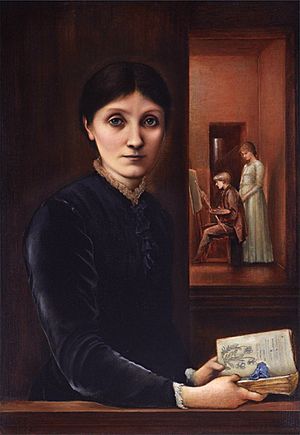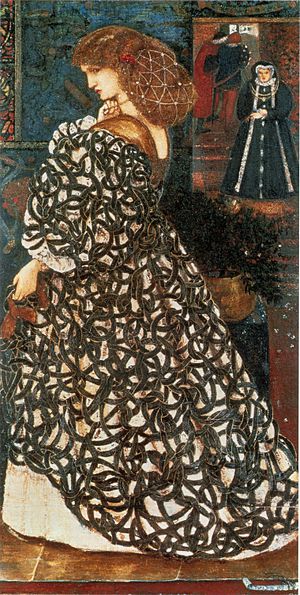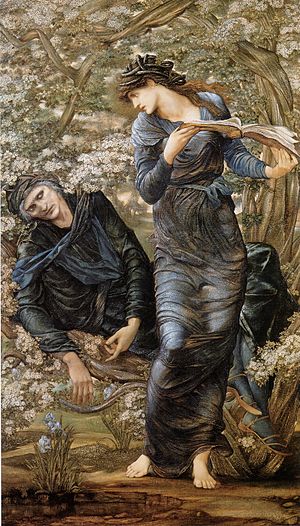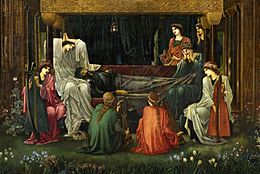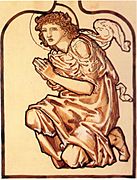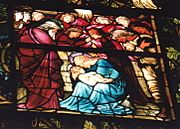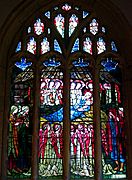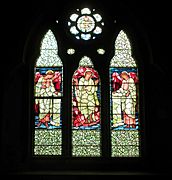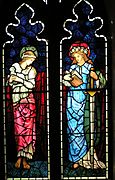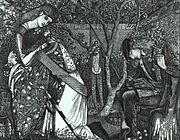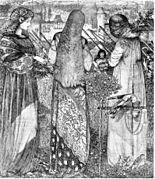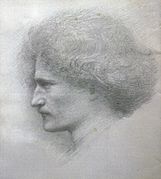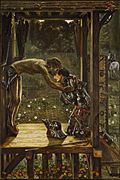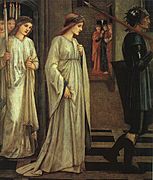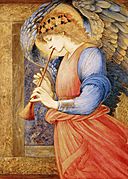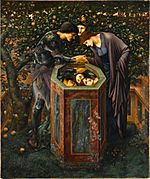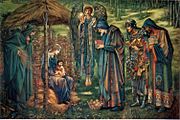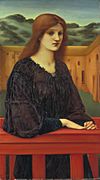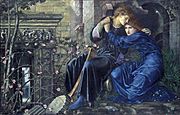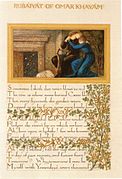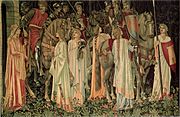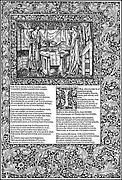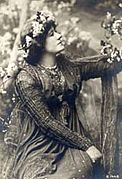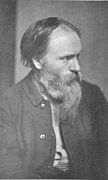Edward Burne-Jones facts for kids
Quick facts for kids
Edward Burne-Jones
Bt ARA
|
|
|---|---|
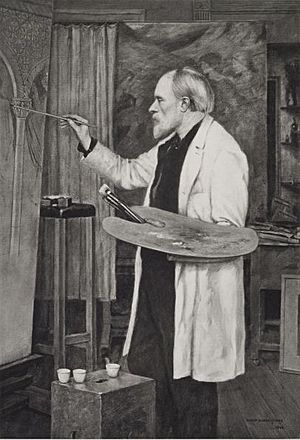
Photogravure of a portrait of Edward Burne-Jones by his son Philip Burne-Jones, 1898
|
|
| Born |
Edward Coley Burne Jones
28 August 1833 Birmingham, England
|
| Died | 17 June 1898 (aged 64) London, England
|
| Known for | Painting |
| Movement |
|
| Spouse(s) | |
Sir Edward Coley Burne-Jones (born August 28, 1833 – died June 17, 1898) was a famous British painter and designer. He was part of a group called the Pre-Raphaelite Brotherhood. This group included artists like Dante Gabriel Rossetti and William Morris.
Burne-Jones also worked closely with William Morris. They started a company called Morris, Marshall, Faulkner & Co. This company designed many beautiful decorative items.
At first, Burne-Jones's paintings looked a lot like Rossetti's work. But by 1870, he had created his own unique style. In 1877, he showed eight oil paintings at a new art space called the Grosvenor Gallery. One of these was The Beguiling of Merlin. People loved his art, and he became a leading artist in the Aesthetic Movement.
In the Morris & Co. studio, Burne-Jones designed many crafts. These included ceramic tiles, jewelry, tapestries, and mosaics. He was especially known for his stained glass windows. This art form became popular again in the 1800s. You can still see his stained glass designs in churches across the UK, the US, and Australia.
Contents
Edward Burne-Jones: His Early Life
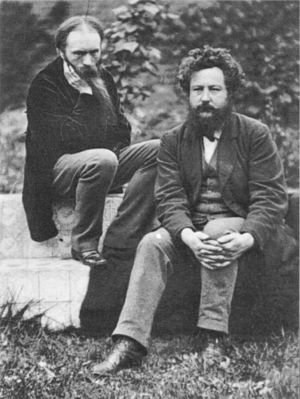
Edward Coley Burne Jones was born in Birmingham, England. His father was a frame-maker. Edward's mother died just six days after he was born. He was raised by his father and the family housekeeper.
He went to King Edward VI grammar school and the Birmingham School of Art. Later, he studied theology at Exeter College, Oxford. At Oxford, he met William Morris. They became good friends because they both loved poetry.
Edward and William, along with friends from Birmingham, formed a group called "The Brotherhood." They read books by John Ruskin and Tennyson. They also visited old churches. They loved the art and ideas of the Middle Ages. During this time, Burne-Jones discovered Le Morte d'Arthur by Thomas Malory. This book about King Arthur greatly influenced his art.
Burne-Jones first planned to become a church minister. But after meeting Rossetti, he and Morris decided to become artists. Burne-Jones left college to follow his dream. In 1857, Rossetti wrote about Burne-Jones:
Jones's designs are marvels of finish and imaginative detail, unequalled by anything unless perhaps Albert Dürer's finest works.
Edward Burne-Jones: Family Life
In 1856, Burne-Jones got engaged to Georgiana "Georgie" MacDonald. She was training to be a painter. They married in 1860. Georgiana later became a close friend of the writer George Eliot.
Georgiana had three sisters. One married artist Sir Edward Poynter. Another married Alfred Baldwin, whose son Stanley Baldwin became Prime Minister. A third sister was the mother of writer Rudyard Kipling. This meant Kipling and Baldwin were Burne-Jones's nephews through marriage.
Edward and Georgiana had a son, Philip, in 1861. In 1864, Georgiana became very ill. They had another son who sadly died soon after. Their daughter Margaret was born in 1866.
In 1867, the family moved to a house called The Grange in North End, Fulham, London. For several years, Burne-Jones did not show his art publicly. This was after some very harsh reviews in the newspapers. During this time, Georgiana became good friends with William Morris.
In 1880, the Burne-Jones family bought a holiday home in Rottingdean, near Brighton. They later bought the house next door and called their property North End House.
His son Philip became a successful portrait painter. His daughter Margaret married John William Mackail, a friend and biographer of William Morris. Margaret's children were the novelists Angela Thirkell and Denis Mackail.
A story from a boys' magazine in 1897 tells how Burne-Jones would draw on the wall for his grandson. If his grandson was sent to stand in the corner, he would find the wall decorated with fairies and animals. This made his punishment less boring!
Edward Burne-Jones: His Art Career
Early Years: Learning and Growing
Burne-Jones once said he was 25 but felt like he should have been 15. He hadn't had much formal art training. But he was very creative and full of ideas from classic stories and medieval tales. He worked hard to improve his skills.
His early works show the influence of Rossetti. But Burne-Jones's art was already different. It had more detailed and imaginative elements. Many of his first works were detailed pen-and-ink drawings. His Waxen Image (1856) is a great example. Rossetti himself saw Burne-Jones's talent and said he had nothing more to teach him.
In 1856, Burne-Jones made his first oil sketch. In 1857, he started designing stained glass windows. He created many of these throughout his career. In 1858, he decorated a cabinet with a scene from Geoffrey Chaucer's Canterbury Tales. Chaucer was a poet he loved and who gave him many ideas for his art.
In 1857, Burne-Jones joined Morris and others in a project to decorate the walls of the Oxford Union. However, the artists didn't know the right painting technique, and the pictures started to peel. In 1859, Burne-Jones traveled to Italy. He visited Florence, Venice, and other cities. He especially liked the gentle and romantic art of the Sienese School.
Painting Style and Success
In 1864, Burne-Jones became a member of the Royal Watercolour Society. He showed his painting The Merciful Knight there. This was the first painting that truly showed his unique artistic style. For the next six years, he showed many beautiful watercolours.
In 1870, Burne-Jones left the society after a disagreement about his painting Phyllis and Demophoön. For the next seven years, he exhibited only two works. One was the lovely Love Among the Ruins (1873). This painting was later accidentally destroyed by a cleaner, but Burne-Jones painted it again in oils.
Even though he wasn't exhibiting much, Burne-Jones was very busy. He started painting more in oils. Works like the first Briar Rose series, Laus Veneris, and The Golden Stairs were planned or started during this time. He also began working with photographer Frederick Hollyer. Hollyer's photos of Burne-Jones's art helped many more people see his work.
In May 1877, Burne-Jones finally received widespread recognition. This was at the first exhibition of the Grosvenor Gallery. He showed The Days of Creation, The Beguiling of Merlin, and The Mirror of Venus. These paintings were a huge success. He followed this with other popular works like Laus Veneris and The Chant d'Amour. Many of these paintings used bright, rich colors.
Around 1879, his colors became softer. This can be seen in The Annunciation and the Pygmalion series. The Golden Stairs, shown in 1880, also used more gentle colors.
In 1883, he showed the serious Wheel of Fortune. In 1884, he painted King Cophetua and the Beggar Maid. In this painting, he returned to using gorgeous, rich colors. He then started two important sets of pictures: The Briar Rose and The Story of Perseus.
Designing Decorative Arts
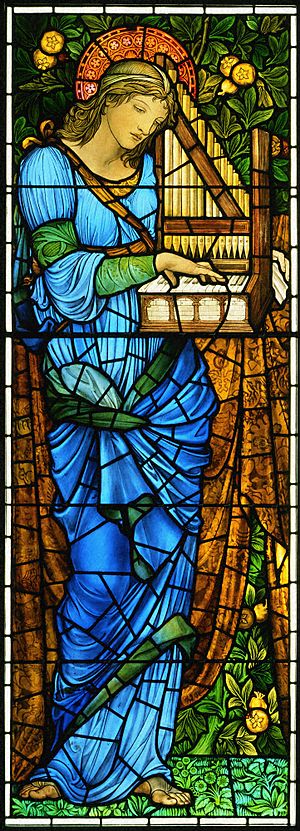
In 1861, William Morris started his decorative arts company, Morris, Marshall, Faulkner & Co. Burne-Jones was a founding partner, along with Rossetti and others. The company made carvings, stained glass, metal-work, wallpapers, and carpets. Decorating churches was a big part of their business.
Their work at the 1862 International Exhibition gained attention. The company became very successful. They decorated the "green dining room" at the South Kensington Museum (now the Victoria and Albert). This room featured stained glass windows and figures designed by Burne-Jones.
In 1871, Morris & Co. made windows for All Saints Church, Wilden. Burne-Jones designed these for his wife's brother-in-law, Alfred Baldwin. The company was renamed Morris & Co. in 1875. Burne-Jones continued to design stained glass and tapestries for them until the end of his life.
You can find his stained glass windows in many churches. These include Christ Church, Oxford, St. Philip's Cathedral, Birmingham, and Holy Trinity Church, Sloane Square, Chelsea.
The company's last major project before Morris's death was Stanmore Hall. For this, Burne-Jones designed figures for a series of Holy Grail tapestries.
Illustrating Books
Burne-Jones was also a talented illustrator. He helped make the Pre-Raphaelite art style more widely known. He designed books for the Kelmscott Press from 1892 to 1898.
His illustrations appeared in books like:
- The Fairy Family (1857)
- The Rubaiyat of Omar Khayyam (1872)
- The Works of Geoffrey Chaucer (1896)
Designing for the Theatre
In 1894, a theatre manager named Henry Irving asked Burne-Jones to design sets and costumes. This was for a play called King Arthur at the Lyceum Theatre. Irving played King Arthur, and Ellen Terry played Guinevere.
Burne-Jones was excited about the project. But he was later disappointed with some of the final results. He wrote to a friend, "I hate the stage, don't tell—but I do."
His Artistic Ideas
Burne-Jones's art was part of a movement called Aestheticism. This idea said that art should be beautiful and make you feel something. It was not just about telling a story or teaching a lesson. This was different from what some earlier artists believed.
Burne-Jones described his goal in art:
I mean by a picture a beautiful, romantic dream of something that never was, never will be – in a light better than any light that ever shone – in a land no one can define or remember, only desire...
He wanted to create a dreamlike world in his art. His paintings show a consistent, dreamlike reality. His characters often seem to be dreamers themselves. This made his art different from the busy, real world of his time.
Burne-Jones worked incredibly hard. He had endless ideas for his art. His paintings always had a strong design. He loved finding beautiful subjects and using pure, varied colors.
Edward Burne-Jones: Later Years
In 1885, Burne-Jones became an Associate of the Royal Academy. The next year, he showed The Depths of the Sea there. This painting of a mermaid carrying a youth is very special among his works. He officially left the Royal Academy in 1893.
He showed some of his Perseus series in 1887 and 1888. In 1890, his second series of The Legend of Briar Rose paintings were exhibited and greatly admired. The huge watercolour, The Star of Bethlehem, was shown in 1891.
Burne-Jones became ill for a time, which slowed his work. When he recovered, he focused on decorative projects. An exhibition of his work was held at the New Gallery in 1892–1893. He painted few portraits during this period.
In 1894, Burne-Jones was made a baronet. This meant he received a special title, "Sir." His health declined after William Morris died in 1896. Burne-Jones suffered from the flu and died on June 17, 1898.
His memorial service was held at Westminster Abbey. This was a great honor for an artist. His ashes were buried in the churchyard at St Margaret's Church, Rottingdean. After his death, another exhibition of his works was held at the New Gallery.
Edward Burne-Jones: Honors and Influence
In 1881, Burne-Jones received an honorary degree from Oxford. In 1885, he became the President of the Birmingham Society of Artists. Around this time, he started using the hyphen in his last name, Burne-Jones. He said it was to stand out from other people named Jones.
He officially became a baronet on May 3, 1894. He was not very happy about accepting this honor. His socialist friend Morris and his wife Georgiana disliked it. Only his son Philip, who would inherit the title, truly wanted it. In 1897, Burne-Jones became a member of the Royal Academy of Science, Letters and Fine Arts of Belgium.
After Burne-Jones died, his memorial service was held at Westminster Abbey. This was a very special event. It was the first time an artist had been honored in this way.
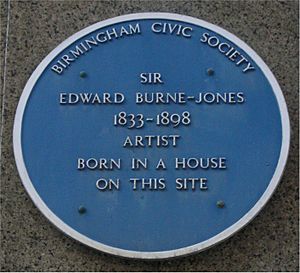
Burne-Jones had a big impact on French painting. He influenced French symbolist painters starting in 1889. His art also inspired poetry, like Swinburne's Poems & Ballads (1866).
Three of Burne-Jones's studio assistants became successful painters themselves. One, Charles Fairfax Murray, later became an important art collector. He sold many of Burne-Jones's and the Pre-Raphaelites' works to the Birmingham Museum & Art Gallery. This museum now has the largest collection of Burne-Jones's art in the world. This includes the huge watercolour Star of Bethlehem. Some believe his paintings influenced the young J. R. R. Tolkien, who grew up in Birmingham.
Burne-Jones also strongly influenced the Birmingham Group of artists in the 1890s.
Edward Burne-Jones: Rediscovery of His Art
For many years, Burne-Jones's art was not very popular. Modern art styles became more favored. In 1933, an exhibition was held to celebrate 100 years since his birth. Prime Minister Stanley Baldwin, Burne-Jones's nephew, opened the exhibition. Baldwin said that Burne-Jones "opened... magic casements of a land of faery." But sadly, not many people attended the exhibition.
It wasn't until the mid-1970s that people started to appreciate his work again. This happened after new books and studies about his art were published. In 1975, Penelope Fitzgerald wrote a biography of Burne-Jones.
In 1998, a large exhibition was held at the Metropolitan Museum of Art in New York. This marked 100 years since his death. It then traveled to the Birmingham Museum and Art Gallery and the Musée d'Orsay in Paris.
Experts now see Burne-Jones as an artist who, while very much from the Victorian era, also looked forward. His art explored deeper feelings and thoughts, leading towards the art of the early 1900s.
Gallery
Stained and Painted Glass
-
Cartoon for Daniel window, St. Martin's-on-the-Hill, Scarborough, 1873
-
Edward Burne-Jones and William Morris' Nativity windows, 1882, Trinity Church, Boston
-
The Worship of the Magi window, 1882, Trinity Church, Boston
-
Nativity scene in St Mary's Church, Huish Episcopi, Somerset
-
Miriam, 1886, in St Giles' Cathedral, Edinburgh
-
Crucifixion window in St James's Church, Staveley, Cumbria
-
Faith in the Old West Kirk, Greenock
-
St Agnes of Rome and Catherine of Alexandria, St Paul, Irton
-
The Ascension, 1898, Jesus Church, Troutbeck, Cumbria
Drawings
-
Portrait of Ignacy Jan Paderewski, 1892
Paintings
Early Works
The Grosvenor Gallery Years
The Legend of Briar Rose (Second Series)
Later Works
-
The Star of Bethlehem, 1890
Decorative Arts
-
Illuminated manuscript of the Rubaiyat of Omar Khayyam by William Morris, illustrated by Burne-Jones with a variant of Love Among the Ruins, 1870s
Theatre Designs
Photographs
-
The Burne-Jones and Morris families in the garden at the Grange, 1874, photograph by Frederick Hollyer
See also
 In Spanish: Edward Burne-Jones para niños
In Spanish: Edward Burne-Jones para niños
- List of paintings by Edward Burne-Jones
- The Flower Book
- Stained Glass Designs for the Vinland House, 1881


